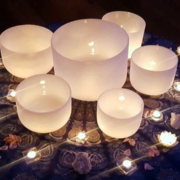UPCOMING EVENTS
Grounded Sound Bath
Saturday December 20th
6:00 pm

Connect with Mother Earth as you immerse yourself in the soothing sound of crystal and Tibetan singing bowls and other meditative instruments for a deeply relaxing & healing inward journey. Grounding mats provided.
*WE HAVE 3 SPACES LEFT*
+++++++++++++
Return of the Light:
Plant Allies for Stress, Depression, and Fatigue
with Kat Maier

Saturday January 31st, 2026, 10am – 5pm
Sunday Morning Tea Ceremonies

with Silvy Franco
Join Silvy for a meditative ceremony to commune with Camelia sinensis. Come for quiet reflection as you sip on several cups of tea following Japanese tradition. Ceremony begins at 9:30 am and goes for an hour. Pre-registration is required.
Suggested Donation: $25




Calendula
/in Herb of the Month /by Ashley Davis(Calendula officinalis)
With Spring in the air, it feels appropriate to celebrate calendula, also known as Herbal Sunshine. Calendula is a great herb for spring detoxification as well as warm-weather skin conditions & first aid.
Family: Asteraceae
Names: pot marigold
Parts Used: whole flowering head
Energetics: primarily bitter, subtly sweet & pungent, warming, drying
Actions: lymphagogue, alterative, vulnerary, bitter tonic/cholagogue, antiseptic, diaphoretic, emmenagogue
Properties & Uses: Calendula brings warmth & light to cold & stagnant places in the body, for the “places where the sun don’t shine” (Chris Hafner, acupuncturist). As a lymphatic herb, Calendula maintains balance in fluid metabolism by clearing stagnation, keeping the channels of elimination open and detoxifying. This helps to keep pathogenic bacteria at bay. Calendula is also antiseptic and vulnerary (speeds tissue repair), making it especially useful in purulent wounds, slow-to-heal wounds, and “swollen, hot, painful, pus-filled tissue” (Matthew Wood). All of these are conditions of damp heat, usually the result of stagnation or coldness in the tissue. Calendula has a soothing, anti-inflammatory quality, reducing itchiness and irritation. It is a valuable remedy for inflammations external and internal in the GI tract. As an alterative, it supports immune function by cleansing the blood of lymphatic congestion & lingering infections. Its warming qualities promote sweating, thin fluids and warm the stomach/solar plexus (Matthew Wood). Calendula is best suited for cold, damp, Kapha conditions & constitutions.
Indications: swollen glands, lingering, unresolved infections (look for swollen tongue with red papillae), sunburn, burns, sores, ulcers, insect bites, swollen, painful, pus-filled tissue, hard-to-cure wounds, candida, gum disease, diaper rash, GI inflammation, leaky gut, painful menstruation, Seasonal Affective Disorder, psychological melancholy, immunological deficiency, symptoms worse in cold/damp weather
Contraindications: avoid large amounts during pregnancy due to emmenagogue action; not appropriate for signs of excess heat/ for hot/fiery constitutions.
Preparation & Dosage: Infusion- 1 ounce of flowers to 1 quart of boiling water; drink 2 cups a day or use externally as a local application. Tincture- 1-4 ml three times a day. Topical preparations include fresh plant poultices or infused oil. Infused oil can be used neat or turned into lotions & salves.
Click Here for a Recipe for Calendula Cream
**This information is for educational purposes only and is not intended to diagnose or treat any disease**